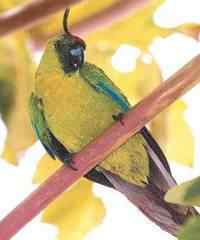帛琉:岛屿鸟类的管理和清除鼠患
国际鸟盟在太平洋岛国帛琉的加盟团体:帛琉保育协会正对付鼠患,侵入的老鼠不但危害原生的鸟类和动物,对人类也有影响。岛屿鼠患是一个保护海鸟和岛屿特有鸟类的重要课题。
http://www.birdlife.org/news/news/2010/04/A-baseline-for-conservation-and-livelihoods-in-Palau.html
A baseline for conservation and livelihoods in Palau
28-04-2010
The Palau Conservation Society (PCS, BirdLife in Palau), together with BirdLife International and other partners, is implementing a project to eradicate invasive alien mammals on the islands of the Kayangel atoll, Palau.
"The restoration of Kayangel Atoll provides an exciting opportunity to not only protect a globally significant site for biodiversity but also demonstrates the value of nature conservation for local people", said Steve Cranwell - Seabird Programme Manager at the BirdLife Pacific Partnership Secretariat.
Kayangel is a priority site for conservation because of the Important Bird Area on the island of Ngeriungs, home to the Endangered Micronesian Megapode Megapodius laperouse.
The small population of people on Kayangel is highly dependent on their environment and natural resources. Invasive species, particularly rats and mice, spread disease and destroy crops. Invasive mammals also decrease the populations of ground nesting birds such as the megapode, and of other biodiversity such as native lizards and crabs.
“ … demonstrates the value of nature conservation for local people” —Steve Cranwell, Seabird Programme Manager at the BirdLife Pacific Partnership Secretariat
PCS and its partners have developed a comprehensive biological, socioeconomic, and organisational monitoring programme to measure the success of the project. This began in March 2010, with the gathering of baseline data.
To determine the project's impacts on biodiversity, PCS and its partners surveyed the population of megapodes, bird diversity, populations and types of crabs and lizards, ant species composition, dominant tree species, invasive species, and general forest health. By surveying so many different targets, project partners will be able to detect changes to individual species and to biodiversity in general.
During the recent monitoring PCS conducted interviews with all 33 adults present. In addition to demographic information, interviewers asked questions about perceived connections between rats and disease, agricultural crop damage, awareness of invasive species, awareness of biosecurity needs and methods, perceptions of the status of Kayangel's natural resources, and awareness of protected areas.
Although PCS has yet to analyse the data and produce a full technical report, PCS found more megapodes on Ngeriungs Island (the average number observed was 19), than on the other three islands in the atoll (Kayangel, Ngerebelas and Orak), where only one to three were observed. Each island was home to around seven species of birds, with a total of only 10 species in the atoll. Rats were observed on all four islands. Cats were confirmed on every island except Orak.
"Quantifying how birds and other biodiversity respond to the removal of introduced rats and cats - as well as being able to demonstrate improvements to peoples health, and enhanced agricultural and livelihood opportunities - provides a persuasive argument for the value of managing Invasive alien species", added Steve. "Furthermore, the community involvement has helped us to learn valuable lessons for other Pacific Island communities".
“we were pleased to see that our general awareness activities on invasive species have been successful” —Anu Gupta, Director of Conservation and Protected Areas at Palau Conservation Society
Most people did not know about the connection between rats and the diseases leptospirosis and scrub typhus. Of the people who had crops, half said that rats had damaged their crops, with some reporting a near 50% loss. Most people had high awareness of invasive species, and were able to list the species and discuss their negative impacts on the environment.
However, few people knew how rats were transported to the island. The majority of respondents said they thought Ngeriungs should be protected, and about half were aware that Ngeriungs qualified as an Important Bird Area.
In addition to serving as a baseline, this survey will help the project partners prioritise awareness activities. "The socio-economic survey is an important component of a comprehensive monitoring plan", said Anu Gupta - Director of Conservation and Protected Areas at Palau Conservation Society. "In addition to providing baseline data for future comparisons, it helps us prioritise our efforts. For instance, we were pleased to see that our general awareness activities on invasive species have been successful. However, it is clear that we need to focus more on biosecurity awareness".
Follow-up biological monitoring will be conducted in six-month intervals after the eradication, and the socioeconomic survey will be repeated one year after the eradication, which is scheduled for 2011.
The work is part of a bigger BirdLife project in Palau and Fiji, "Restoration of Priority Pacific Island Ecosystems for People and Biodiversity". The project is funded by the UK Government's Darwin Initiative, and co-financed by the Micronesia Conservation Trust. Read more about the project here.













发表评论:
◎欢迎参与讨论,请在这里发表您的提问或看法,交流您的观点。